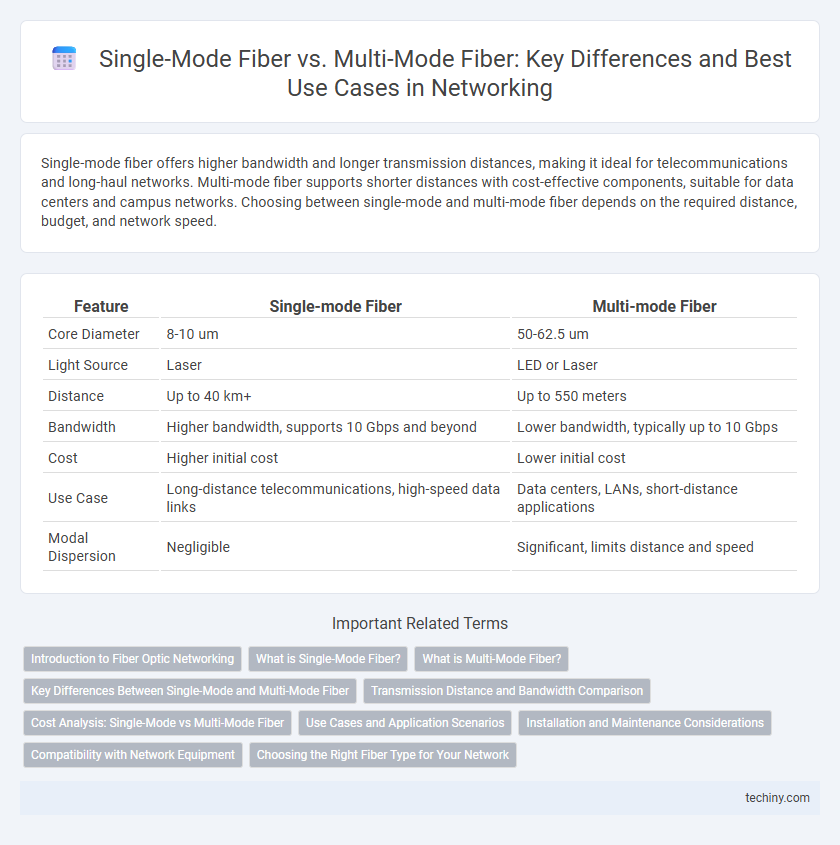Single-mode fiber offers higher bandwidth and longer transmission distances, making it ideal for telecommunications and long-haul networks. Multi-mode fiber supports shorter distances with cost-effective components, suitable for data centers and campus networks. Choosing between single-mode and multi-mode fiber depends on the required distance, budget, and network speed.
Table of Comparison
| Feature | Single-mode Fiber | Multi-mode Fiber |
|---|---|---|
| Core Diameter | 8-10 um | 50-62.5 um |
| Light Source | Laser | LED or Laser |
| Distance | Up to 40 km+ | Up to 550 meters |
| Bandwidth | Higher bandwidth, supports 10 Gbps and beyond | Lower bandwidth, typically up to 10 Gbps |
| Cost | Higher initial cost | Lower initial cost |
| Use Case | Long-distance telecommunications, high-speed data links | Data centers, LANs, short-distance applications |
| Modal Dispersion | Negligible | Significant, limits distance and speed |
Introduction to Fiber Optic Networking
Single-mode fiber uses a single light path for long-distance, high-bandwidth data transmission, making it ideal for telecommunications and internet backbone infrastructure. Multi-mode fiber supports multiple light paths, offering greater flexibility and cost-effectiveness for shorter distances within data centers and local area networks. Understanding these differences enhances network design efficiency by aligning fiber type with specific performance and distance requirements.
What is Single-Mode Fiber?
Single-mode fiber is an optical fiber designed to carry light directly down the fiber with a small core diameter of approximately 8 to 10 microns, allowing only one mode of light to propagate. This type of fiber is ideal for long-distance communication due to its low attenuation and minimal signal dispersion, supporting data transmissions over tens of kilometers or more. Single-mode fiber is widely used in telecommunications, internet backbone infrastructure, and high-speed data networks requiring high bandwidth and reliable performance.
What is Multi-Mode Fiber?
Multi-mode fiber is an optical fiber designed to carry multiple light modes or rays simultaneously, primarily used for short-distance data transmission. It features a larger core diameter, typically 50 or 62.5 microns, allowing multiple light paths and enabling higher bandwidth over shorter distances, such as within data centers or local area networks (LANs). Multi-mode fiber supports transmission speeds up to 100 Gbps over distances up to 600 meters, making it ideal for enterprise networking environments.
Key Differences Between Single-Mode and Multi-Mode Fiber
Single-mode fiber uses a small core diameter of approximately 8 to 10 microns, enabling long-distance data transmission with minimal signal loss and higher bandwidth capacity due to a single light path, while multi-mode fiber has a larger core size of about 50 to 62.5 microns facilitating multiple light modes, which results in higher modal dispersion and limits its effective transmission distance. Single-mode fibers are ideal for telecommunications and long-haul networks, whereas multi-mode fibers are commonly employed in LANs and data centers for shorter distances and lower cost deployments.
Transmission Distance and Bandwidth Comparison
Single-mode fiber supports longer transmission distances, typically exceeding 40 kilometers, by using a single light path that reduces modal dispersion, making it ideal for high-bandwidth applications across extended networks. Multi-mode fiber, designed for shorter distances up to 2 kilometers, supports multiple light paths which increase modal dispersion but provide cost-effective solutions for local area networks with moderate bandwidth needs. The bandwidth capacity of single-mode fiber can reach TEM00 modes at 10 Gbps and beyond, while multi-mode fiber bandwidth is limited by modal dispersion and core size, typically supporting speeds up to 100 Gbps over shorter links.
Cost Analysis: Single-Mode vs Multi-Mode Fiber
Single-mode fiber incurs higher initial costs due to more expensive laser sources and precision installation requirements, whereas multi-mode fiber benefits from lower-cost LEDs and easier termination processes. Though single-mode fiber offers longer transmission distances and higher bandwidth, multi-mode fiber is often more cost-effective for short-range applications like data centers and enterprise networks. Total cost of ownership for multi-mode fiber typically remains lower in environments with limited distance demands, while single-mode fiber proves economical over time in large-scale, high-performance networks.
Use Cases and Application Scenarios
Single-mode fiber excels in long-distance telecommunications and high-bandwidth applications, making it ideal for metro, regional, and long-haul networks where minimal signal attenuation and high transmission rates are critical. Multi-mode fiber suits short-distance data center connections, local area networks (LANs), and enterprise campus environments due to its cost-effectiveness and compatibility with LED and VCSEL light sources. Choosing between single-mode and multi-mode fiber depends on factors such as transmission distance, bandwidth requirements, and overall network architecture.
Installation and Maintenance Considerations
Single-mode fiber requires precise alignment and highly clean connectors during installation due to its small core size, increasing the need for skilled technicians and specialized equipment. Maintenance is generally less frequent but more costly, as damage or contamination can significantly impact signal quality over long distances. Multi-mode fiber offers easier installation with larger core diameters that tolerate more connector flex and dirt, resulting in lower initial maintenance efforts but higher potential attenuation and modal dispersion over time.
Compatibility with Network Equipment
Single-mode fiber is compatible with long-distance, high-bandwidth network equipment such as DWDM systems and high-speed optical transceivers, enabling seamless integration in enterprise and carrier networks. Multi-mode fiber works best with short-distance network devices like Ethernet switches and LAN connectivity hardware that utilize LED or VCSEL light sources. Network equipment compatibility depends on the fiber type's core diameter and modal dispersion characteristics, affecting signal quality and distance capacity.
Choosing the Right Fiber Type for Your Network
Choosing the right fiber type for your network depends on distance, bandwidth requirements, and budget considerations. Single-mode fiber offers higher bandwidth and longer transmission distances, making it ideal for long-haul telecommunications and campus networks. Multi-mode fiber provides cost-effective solutions for shorter distances within data centers and enterprise environments, supporting high-speed data transmission.
Single-mode Fiber vs Multi-mode Fiber Infographic

 techiny.com
techiny.com